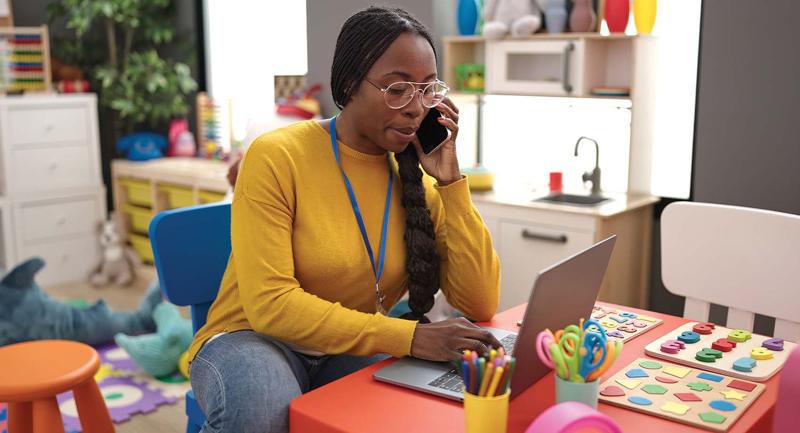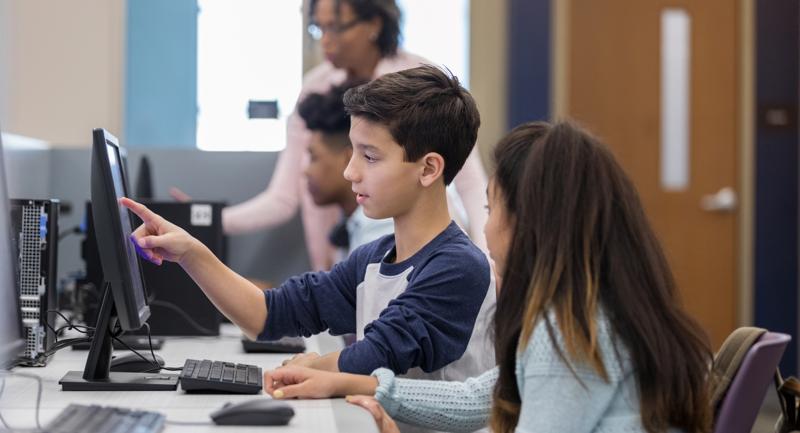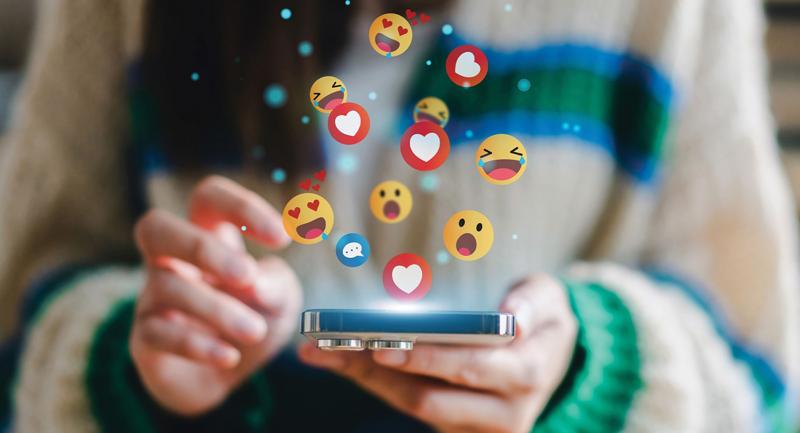How would you define a digital problem solver? Someone who can troubleshoot a finicky device? A person who can determine quality information from misinformation? Maybe a “superhero” with the power to resist social media algorithms and escape the endless scroll of TikTok or YouTube in order to get a full eight hours of sleep? Or, perhaps when you try to picture a digital problem solver, you imagine teens like X Gonzalez, David Hogg, and their classmates who took to social media to speak out against gun violence after the 2018 shooting at their high school in Parkland, Florida.
No matter which version of the digital problem solver resonates with you, parents and educators alike recognize that we haven’t quite figured out the best approaches for raising and educating our young digital citizens in ways that simultaneously protect and empower them in digital landscapes.
As both a parent and teacher, I’ve often felt that keeping up with teenagers and the internet is like a game of Whac-A-Mole. When we finally get our collective heads around the latest apps, internet slang, dangerous scams, or destructive trends, the kids pivot on us! They move to new platforms, come up with new ways to bend the rules we’ve set for them, and do weird or creative things we would have never anticipated needing to talk with them about. Our attempts at educating and guiding these digital citizens are often reactive, not proactive, and can feel absolutely exhausting.
Hits and Misses in Digital Citizenship Education
During the late 1990s and early 2000s, the integration of technology into schools and public libraries was accelerated by initiatives like the federal E-Rate program, which allocated money toward improved internet access. It also mandated compliance with internet safety measures under the Children’s Internet Protection Act of 2001 and required schools to deliver education about appropriate online conduct (Federal Communications Commission, 2019).
In those early days, schools often relied on local law enforcement to deliver generic online safety messages to students, in a manner akin to drug education programs. While this approach technically satisfied the E-Rate educational requirement, it lacked the depth needed for effective digital citizenship education to take hold (Jones et al., 2012). The first widely used internet-safety curriculum, NetSmartz, was developed by the National Center for Missing & Exploited Children with funding from the U.S. Department of Justice in 2001. As it evolved, this program allowed classroom teachers to take over the lectures that had been previously outsourced to police, but the curriculum still relied heavily on scare tactics and sensationalized stories warning children not to talk to strangers on the internet (Mattson, 2016).
In the end, Digital Citizenship 1.0 failed to teach students any practical skills for successfully navigating an online world and relied heavily on a curriculum of “don’ts” to try to keep students safe.
We must be strategic in maximizing our instructional time by creatively integrating digital citizenship alongside content-area learning.
The goals of digital citizenship education began shifting in the 20-teens, mostly through social media conversations among educators. Platforms like Twitter (now X) and Instagram helped teachers embrace the power of social media for their own professional networking, idea-sharing, and collaboration. Tony Sinanis and Joseph Sanfelippo’s book The Power of Branding (2014) highlighted how social media can tell a school’s story, showcase student achievements, build a school’s brand, and strengthen home and school connections. Edtech influencers advocated for social media education in schools with blog posts like, “Why Every High School Should Teach a Social Media Class” (Geurin, 2016) and “3 Reasons Students Should Own Your Classroom’s Twitter and Instagram Accounts” (Dornfeld, 2016).
Digital Citizenship 2.0 reflected a pendulum swing away from teaching students the “don’ts” of online behavior to empowering them with the “dos.” This shift was further cemented in 2016 when ISTE updated its Standards for Students to emphasize the opportunities, not just the risks, of living in a digital world. The standards said students should manage their digital identities, engage online, share intellectual property responsibly, and maintain digital privacy and security. The modified language reinforced an expectation that students actively participate in the online world with the guidance of their teachers. The COVID-19 pandemic and the shift to remote learning further underscored the need to teach students digital skills, repositioning digital citizenship education from an E-Rate requirement that existed on the fringes of to-do lists to an essential component of modern learning.
I believe we are now at another turning point—a point where we need to transition to Digital Citizenship 3.0. As society debates the complex issues around misinformation, social media’s impact on mental health, and AI regulation, we need to acknowledge that even the grown-ups don’t have all the answers. Instead of relying on a curriculum that presents students with the black and white “dos and don’ts” of the digital world, Digital Citizenship 3.0 must invite nuanced, gray-area discussions, respect student voice and experience, value diverse perspectives, and—perhaps most important of all—foster critical thinking.
Toward Digital Citizenship 3.0
Digital citizenship has been recently defined as “The skills needed for youth to fully participate academically, socially, ethically, politically, and economically in our rapidly evolving digital world” (Cortesi et al., 2020). However, there is one glaring barrier in our approach to digital citizenship education that prevents us from teaching to the extent of this broad definition: We lack the type of clear instructional outcomes for students to work toward that are outlined by learning standards in nearly every other content area. We also lack an identified progression of skills and content knowledge to scaffold and support students toward such outcomes.
When we say we want students to be “digital problem solvers” or ask them to embrace “digital well-being,” have we determined what that looks like in action? What skills and content knowledge must an 18-year-old possess to be a socially conscious digital citizen? What should a media literate 12-year-old be able to do? In what ways does the topic of digital safety become increasingly complex as students move from elementary to middle to high school? Without outcome goals and a clear progression of skills, teachers are left to select curricular resources at random, leading to gaps or overlaps in students’ exposure to content knowledge and opportunities for practicing skills.
Transitioning to Digital Citizenship 3.0 requires us to address these barriers by advocating for a curriculum that prioritizes transferable skills and concepts as opposed to strict rules and platform-specific technology tips that may go out of style as quickly as the latest TikTok trend. Instead, educators can invite students to reflect on the complexities of our digital world in age-appropriate ways and ensure they have the critical thinking skills to navigate it thoughtfully and responsibly, regardless of how technology may change.
In 2021, edtech specialist LeeAnn Lindsey and I developed the Edvolve Digital Citizenship Curricular Framework to address these issues. This free, comprehensive guide was designed to support a systematic yet adaptable approach to teaching Digital Citizenship 3.0. It comprises a 30-page document that includes enduring understandings, grade-level indicators, guiding questions, technology skills, and alignment to many national sets of content-area standards. The framework defines digital citizenship through four strands: digital safety, media and information literacy, digital well-being, and social responsibility. It offers 13 enduring understandings that span grade levels and contexts and illustrates a progression toward mastery through grade-level indicators of success. In addition, the framework offers broad, open-ended questions that can inspire teachers as they create lessons designed to help students broaden their understanding of the complexities and opportunities of our increasingly digitally connected and driven world.
Hacking Digital Citizenship into the Content Areas
Even with clear instructional outcomes and an agreed upon progression of skills, teaching a comprehensive digital citizenship curriculum presents a significant challenge: finding enough time in the school day to get it all done. While we may be in agreement that digital problem-solving skills and habits are important, educators face competing curricular priorities and rigid bell schedules that leave very little wiggle room for “extras” like digital well-being or media literacy. We obviously can’t create more time in the day, so we must be strategic in maximizing our instructional time by creatively integrating digital citizenship alongside content-area learning.
An easy way to hack digital citizenship into the school day at the elementary level is through read alouds. Students can practice all the required literacy goals like summarizing plots, analyzing conflicts, and comparing and contrasting themes while absorbing books on nuanced digital topics. Some must-have titles include Nerdy Birdy Tweets (Reynolds, 2017), which explores the pros and cons of online and offline friends, and Killer Underwear Invasion (Gravel, 2022), which introduces students to the concept of misinformation and conspiracy theories in a fun, graphic novel format. Similarly, remixed fairy tales like #Goldilocks (Willis, 2019) and Once Upon a Time Online (Bedford, 2017) help students explore digital safety themes through familiar narratives while comparing and contrasting various versions of the same stories. (For a complete list of recommended picture books, visit teachdigcit.com/picturebooks.) In a middle school health classroom, hacking digital citizenship into the curriculum might look like a simple makeover or update to a traditional unit of instruction. The National Health Education Standards (Joint Committee on National Health Education Standards, 2012) call on students to “analyze how peers influence healthy and unhealthy behaviors.” Traditional peer-pressure-related instruction focuses on topics like drug and alcohol use or pressure to cheat, steal, or lie. But how might our instruction, examples, and topics for class discussion change if we worked the word digital into the existing health standard? Students could then “analyze how peers influence healthy and unhealthy digital behaviors.” Such questions allow us to honor students’ voices and their wealth of experience in online settings—while also helping them navigate and learn from complex situations.
Meanwhile, the high school social studies classroom provides many opportunities to pair digital citizenship instruction with content-area learning. As students learn about engaging in the democratic process, they might also debate the question, “Is online slacktivism an effective form of activism?” In addition, they might examine current events through social media posts, identifying potential pieces of misinformation and pausing to practice fact-checking skills like lateral reading.
Figure 1 offers some additional suggestions for hacking digital citizenship into existing content-area lessons. Adopting a stand-alone digital citizenship curriculum is bound to make teachers feel like they have “one more thing” added to their plates. The more integrated approach I am recommending, by contrast, encourages educators to view every lesson through a digital citizenship lens in order to enhance and modernize their curriculum while also offering our digital citizens opportunities to refine their skills for both the offline and online worlds.
Exploring in the Gray Areas, Together
As you consider new ways to approach digital citizenship education, just remember that in the face of changing technology, there is one skill set that will never go out of style or be downgraded: critical thinking. The more opportunities our students have to build their decision-making and evaluative muscles, the better. So let’s invite them to wrestle with questions that do not have single, correct answers. Let’s encourage students to consider topics of digital life through various perspectives. And finally, let’s challenge ourselves to explore the gray areas at the intersection of technology and humanity: together.
Reflect & Discuss
➛ Do you think your school or district’s approach to teaching digital citizenship has been effective? Why or why not?
➛ In what ways could you better integrate digital citizenship education across subject areas in your school or district?
➛ What does digital citizenship education mean to you? What would it look like in an ideal state?









